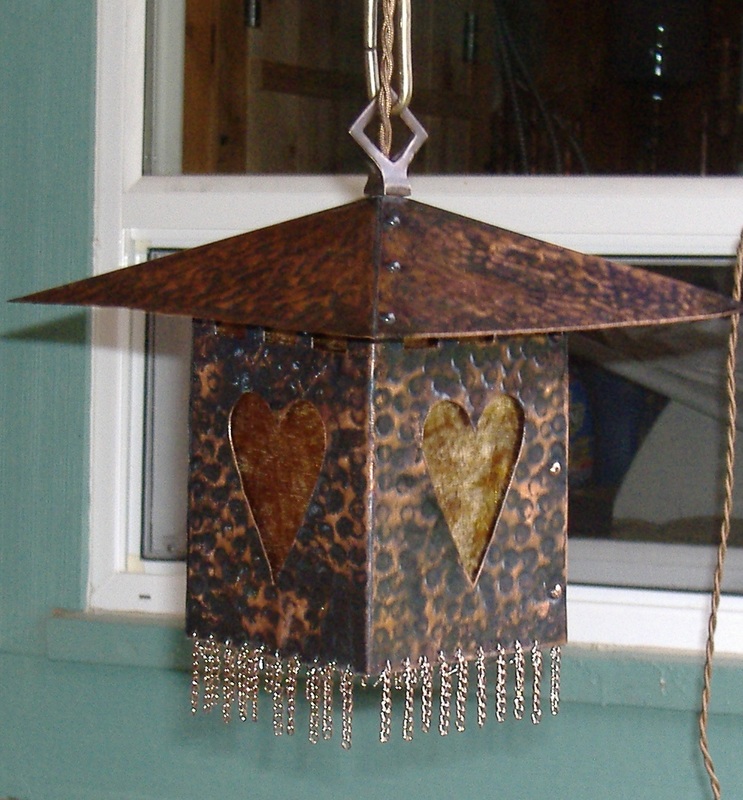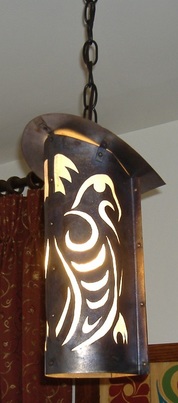We are all a product of our times, and my developmental years extended through the 1960's and early 1970's. This was a time of considerable social change (what time isn’t?). It saw the birth of the environmental and back-to-nature movements and a communal way of life created in a response to the impersonal effects of urbanization, pollution, mass marketing, mass production, and commercialism. As a child and teen during this period, I consciously or unconsciously was affected by the tug of war between conventional principles and these new ideas of how to approach one’s life.
Meanwhile, at this same time, much of the art that was found in our home was the product of either my mother or my sister, Renee. I recall that one wall of my childhood bedroom was covered with a large mural painted by my mom. The mural changed over the years, but its effect was the same: to instill in me a love of art and a desire to create art myself.
In the summer of 1974 I came to La Conner to work at Washington State University’s Fishtown archeological project. Every day we made the trek from our tent camp at Margaret Lee’s farm down the boardwalk and along the Skagit River to the dig site. In passing the artists' shacks along the route, I was taken by the funky creativity evident in their design. I never had the chance to meet any of Fishtown’s resident artists, but living so close to nature, they greatly inspired me to pursue art on my own. I was able to continue this goal while living at the Ozette Village archeological site along the Pacific coast. In blissful isolation and surrounded by stunning natural beauty, I tried to develop my own personal philosophy of art and its application through painting.
However “new” this philosophy was for me, some of these ideas were actually a return to the same concerns and conditions which were facing 19th century Victorian Britain. The Industrial Revolution in Britain caused a major sociological shift in British society, creating new wealth and a growing middle class, yet diverting a large percentage of a once rural/agricultural based population to the factories and slums of the city. A socially-conscious Morris believed that a return to conditions prevalent in the medieval craftsmen's guild system could save the worker from the drudgery and poverty of factory work. He also saw this as a means of manufacturing quality products in response to the prevalence of cheap and poorly-made items for sale at the time. From these beliefs a methodology emerged, eventually taking on the moniker of The Arts and Crafts Movement, a movement which spread to continental Europe, America, and even to Japan (thanks to Soetsu Yanagi and the Mingei Movement) as the 20th century emerged. After I was first introduced to this late 19th century-early 20th century movement, I was fascinated in the many parallels that existed between it and my already-formed beliefs about art.
Some Parallels with the Arts & Crafts Movement
1. I am involved in almost all of the processes in the creation of my artwork: from preparing the cedar, to designing and painting the image, and finally in the making of the red oak frame. I want to maintain the marriage of artist and craftsman. I may be expert in neither but hope the finished product reflects my level of commitment and passion. The only steps I am unable to do involve the milling of the wood. I am reconciled to purchasing already lumbered cedar and red oak.
2. I try to do as much as possible by hand with a limited use of power tools. I do not have power to my shop, thus reducing my power tools to a drill and an orbital sander. I otherwise use a Japanese backsaw (ryōba), a miter saw, and chisels to cut my boards to the desired length and to create the mortise-and-tenon joints for my frames.
3. I am fascinated with the natural world and with the beauty and sense of peacefulness found there. I have been fortunate to live in the Pacific Northwest and to experience the beauty of its coastlines, mountains and forests. I am also enthralled by the native plants and animals which call the Northwest home. Finally, I have had the opportunity to visit the Highlands and Islands of Scotland and to marvel at its stark beauty and sense of openness and isolation. I try to express this love of nature in my designs
4. I have a reverence for the past and for cultural tradition. I am not fond of the “New and Improved” aspects of contemporary art where it seems the main emphasis is on trying to be new and /or different. The problem is that nothing remains “new” for long and “modern” becomes old in the blink of an eye. Cultural tradition, regardless of whose culture one identifies with, plays a major role in determining who we are as a people. By shedding our traditions so haphazardly, we have become incomplete, which explains why so many of us feel empty at times and in search of something to fill the void. I strive to do extensive research as a means of inspiration, constantly adding to my library. I try to honor the past in every piece I do, yet at the same time try to stay fresh and true to self.
5. My undergraduate degree in Anthropology from Penn State (with help from Washington State and the University of Washington) has given me a strong multicultural perspective. Coming from and proud of my own Italian heritage, I have been fortunate to add a layer of Scottish-ness and Southern American from my wife, Leigh. To top it off, having the opportunity of being immersed in a strong and vibrant Makah culture for the over-twenty years we taught in Neah Bay helped to develop a unique blended value system. Thus I strive to incorporate elements from Native American, Celtic, and Japanese influences in my designs.
6. I am extremely fortunate to be able to paint without the harsh economic pressure to sell my artwork. This allows me to paint, not what might best sell, but what I hope to express. Thus, the process of making art can become for me more important than the final product or its potential sale.
7. I am more concerned with creating art to the best of my abilities than with striving for perfection. Gustav Stickley suggested this when he included in his trademark the phrase Als Ik Kan, meaning “to the best of my ability”. Due to my abilities, and limitations thereof, the achievement of perfection is not within my grasp. I do not strive for any sense of imperfection (nor exactly to try to fit in with the concept of wabi-sabi); however, I am comfortable with it. With imperfection comes the opportunity to learn. In general I am mostly concerned for the passion inherent in the raw product.
8. Ideally I would like to create art which was functional rather than purely decorative. I have tried to do this in two ways. First, I have incorporated my painted designs on boxes, screens, mirror frames, and even a pair of sconces. These obviously have a use, and we have used my boxes as storage containers, plant stands, to hold CDs, and as a holder of our TV remotes. We have used my screens as room dividers and as summertime fireplace screens. The second, and less obvious, way involves painted “wall art”. My intention is that these paintings “function” to act as a visual mode of expressing meaningful events in my life. They are designed to tell a story in images rather than in words, or to act as a visual clue to a story, event, or experience.
9. Finally, I hope to address a truthfulness to the materials with which I work. I work in western red cedar, a wood of great cultural, spiritual, and environmental significance to the Pacific Northwest. I love the grain patterns in wood and try to use the flow of the grain in my designs. The red oak frames are an integral part of the composition and the paintings are naked and incomplete without them. I strive to limit the amount of waste in the production of my art in reverence to the wood.
In closing, my image of the artist/craftsman developed from my interest in Native Northwest Coast art and from the master carvers and painters who created some of the finest examples of functional art, not only in the Americas, but also in the world. The ideal or standard behind my art was based specifically on the native Tsimshian artists who designed and painted the 19th century house fronts at Fort Simpson, BC. These house fronts were painted by master artists for a set cultural purpose. These paintings were not necessarily expected to survive any length of time as the weather and elements worked against them. Often the planks were even taken down and burned following the event for which they were painted. To me these painters were the epitome of the artist/craftsman working within a cultural context for a specific purpose. Ultimately they are the driving force behind my paintings.
“Every artist knows that he is engaged in an encounter with infinity, and that work done with heart and hand is ultimately worship of Life Itself.”
Yanagi Soetsu (adapted by Bernard Leach), The Unknown Craftsman: A Japanese Insight into Beauty, ©1989, pages 89-90.


 RSS Feed
RSS Feed